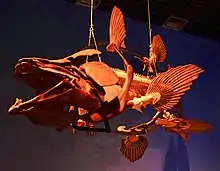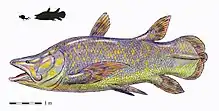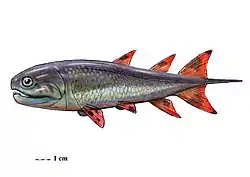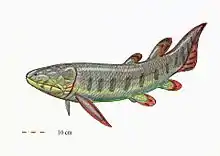Mawsonia (fish)
Mawsonia is an extinct genus of prehistoric coelacanth fish, and the largest of this group, ranging from an estimated 3.5 metres (11.5 feet) up to 6.3 metres (20.7 feet) long.[2][3] It lived during the Cretaceous period (Albian and Cenomanian stages, about 99 to 112 million years ago). Fossils have been found in the Bahia Group, Romualdo, Alcântara and Missão Velha Formations of Brazil, South America, as well as the Continental Intercalaire of Algeria and Tunisia, the Ain el Guettar Formation of Tunisia, and the Babouri Figuil Basin of Cameroon, Africa. Mawsonia was first described by British palaeontology Arthur Smith Woodward in 1907.[4] The type species is Mawsonia gigas, named and described in 1907. Numerous distinct species have been described since then. M. brasiliensis, M. libyca, M. minor, and M. ubangiensis have all been proposed to be synonyms of M. gigas,[3][5] although Léo Fragoso's 2014 thesis on mawsoniids[6] finds M. brasiliensis valid and cautions against synonymizing M. minor without further examination. Several recent publications consider M. brasiliensis to be valid as well.[5][7][8][9] Although initially considered to belong to this genus, "Mawsonia" lavocati is most likely referable to Axelrodichthys instead.[9][10]
| Mawsonia | |
|---|---|
 | |
| Reconstructed skeleton of Mawsonia at the National Museum of Nature and Science, Tokyo | |
| Scientific classification | |
| Kingdom: | Animalia |
| Phylum: | Chordata |
| Order: | Coelacanthiformes |
| Family: | †Mawsoniidae |
| Genus: | †Mawsonia Woodward, 1907 |
| Species | |
| |

Description
The fish has six fins: two on the top of the body, two on the sides, one at the end of its tail and one at the bottom of its tail.
References
- Sereno, P. C.; Dutheil, D. B.; Iarochene, M.; Larsson HCE; Lyon, G. H.; Magwene, P. M.; Sidor, C. A.; Varricchio, D. J.; Wilson, J. A. (1996). "Predatory Dinosaurs from the Sahara and Late Cretaceous Faunal Differentiation". Science. 272 (5264): 986–91. Bibcode:1996Sci...272..986S. doi:10.1126/science.272.5264.986. PMID 8662584.
- Dutel, Hugo; Pennetier, Elisabeth; Pennetier, Gérard (2014-07-29). "A giant marine coelacanth from the Jurassic of Normandy, France". Journal of Vertebrate Paleontology. 34 (5): 1239–1242. doi:10.1080/02724634.2014.838176. ISSN 0272-4634.
- de Carvalho, Marise S. S.; Maisey, John G. (2008). "New occurrence of Mawsonia (Sarcopterygii: Actinistia) from the Early Cretaceous of the Sanfranciscana Basin, Minas Gerais, southeastern Brazil". Geological Society, London, Special Publications. 295 (1): 109–144. doi:10.1144/sp295.8. ISSN 0305-8719.
- Mawsonia at Fossilworks.org
- Cupello, Camila; Batista, Thatiany A.; Fragoso, Léo G.; Brito, Paulo M. (2016-10-01). "Mawsoniid remains (Sarcopterygii: Actinistia) from the lacustrine Missão Velha Formation (Lower Cretaceous) of the Araripe Basin, North-East Brazil". Cretaceous Research. 65: 10–16. doi:10.1016/j.cretres.2016.04.009. ISSN 0195-6671.
- Fragoso, Léo (2014). "Revisão do Ramo Gondwânico da família Mawsoniidae (Sarcopterygii: Actinistia: Coelacanthiformes)". Doctoral Dissertation, Universidade do Estado do Rio de Janeiro.
- Batista, Thatiany Alencar; Bantim, Renan Alfredo Machado; Lima, Flaviana Jorge de; Santos Filho, Edilson Bezerra dos; Saraiva, Antônio Álamo Feitosa (2019-11-01). "New data on the coelacanth fish-fauna (Mawsoniidae) from the Late Jurassic and Early Cretaceous of Araripe Basin, Brazil". Journal of South American Earth Sciences. 95: 102280. doi:10.1016/j.jsames.2019.102280. ISSN 0895-9811.
- Cavin, Lionel; Cupello, Camila; Yabumoto, Yoshitaka; Léo, Fragoso; Deersi, Uthumporn; Brito, Paul M. (2019). "Phylogeny and evolutionary history of mawsoniid coelacanths" (PDF). Bulletin of the Kitakyushu Museum of Natural History and Human History, Series A. 17: 3–13.
- Fragoso, Léo Galvão Carnier; Brito, Paulo; Yabumoto, Yoshitaka (2019-11-26). "Axelrodichthys araripensis Maisey, 1986 revisited". Historical Biology. 31 (10): 1350–1372. doi:10.1080/08912963.2018.1454443. ISSN 0891-2963.
- Ibrahim, Nizar; Sereno, Paul C.; Varricchio, David J.; Martill, David M.; Dutheil, Didier B.; Unwin, David M.; Baidder, Lahssen; Larsson, Hans C. E.; Zouhri, Samir; Kaoukaya, Abdelhadi (2020-04-21). "Geology and paleontology of the Upper Cretaceous Kem Kem Group of eastern Morocco". ZooKeys. 928: 1–216. doi:10.3897/zookeys.928.47517. ISSN 1313-2970. PMC 7188693. PMID 32362741.
Further reading
- Fishes of the World by Joseph S. Nelson
- History of the Coelacanth Fishes by Peter Forey
- Discovering Fossil Fishes by John Maisey and John G. Maisey
- The Rise of Fishes: 500 Million Years of Evolution by John A. Long
- Evolution of Fossil Ecosystems by Paul Selden and John Nudds

.jpg.webp)


